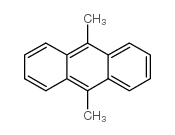Liposome binding constants and singlet oxygen quantum yields of hypericin, tetrahydroxy helianthrone and their derivatives: studies in organic solutions and in liposomes.
M Roslaniec, H Weitman, D Freeman, Y Mazur, B Ehrenberg
Index: J. Photochem. Photobiol. B, Biol. 57(2-3) , 149-58, (2000)
Full Text: HTML
Abstract
The spectroscopy and photophysics of several hypericin and helianthrone derivatives were studied in methanol and when bound to liposomes. The singlet oxygen quantum yields (phi(delta)) were measured indirectly relative to Rose Bengal and hematoporphyrin IX, employing 9,10-dimethylanthracene as a singlet oxygen trap. Hypericin was found to have a phi(delta) of 0.39+/-0.01 in methanol, and 0.35+/-0.05 in lecithin vesicles, in agreement with literature values. A heavy atom effect was evident upon bromination, resulting in phi(delta) for tetrabromohypericin of 0.72+/-0.02, presumably due to enhanced intersystem crossing. Elimination of the anionic hydroxyls by methylation also enhanced phi(delta) to 0.81+/-0.01. Conversely, addition of anionic sulfate groups drastically reduced phi(delta) resulting in phi(delta)'s of 0.12+/-0.01, 0.052+/-0.003 and 0.40+/-0.01 for hypericin disulfonate, hypericin tetrasulfonate and hexamethyl hypericin tetrasulfonate, respectively. The non-sulfonated helianthrones exhibited low phi(delta)'s in solution. The liposome binding constants, Kb, were measured using a spectroscopic assay. Except for hexamethyl hypericin, all non-sulfonated compounds bound well with Kb's ranging from 15.5+/-0.1 to 48.7+/-3.9 (mg/ml)(-1). None of the tetrasulfonated compounds bound, however the hypericin disulfonate had a Kb of 4.1+/-0.2 (mg/ml)(-1). The phi(delta)'s of the compounds capable of binding were measured and, in the case of the hypericin derivatives, were found not to vary dramatically from those in the free state. Liposome-bound helianthrone and dimethyl tetrahydroxy helianthrone both exhibited high phi(delta)'s, i.e. >0.5. The variations in binding constant and sensitization efficiencies are explained in conjunction with the molecular structure. The relevance of the above data to photodynamic therapy is briefly discussed.
Related Compounds
| Structure | Name/CAS No. | Molecular Formula | Articles |
|---|---|---|---|
 |
9,10-Dimethylanthracene
CAS:781-43-1 |
C16H14 |
|
QSPR modeling of octanol/water partition coefficient for vit...
2008-04-01 [Eur. J. Med. Chem. 43 , 714-40, (2008)] |
|
Antioxidant-photosensitizer dual-loaded polymeric micelles w...
2014-08-25 [Int. J. Pharm. 471(1-2) , 339-48, (2014)] |
|
Determination of descriptors for polycyclic aromatic hydroca...
2014-09-26 [J. Chromatogr. A. 1361 , 240-54, (2014)] |
|
Genotoxic potency in Drosophila melanogaster of selected aro...
1993-12-01 [Mutat. Res. 290(2) , 175-82, (1993)] |
|
Immunomodulatory effects of dietary exposure to selected pol...
2010-01-01 [Int. J. Toxicol. 29(5) , 532-45, (2010)] |